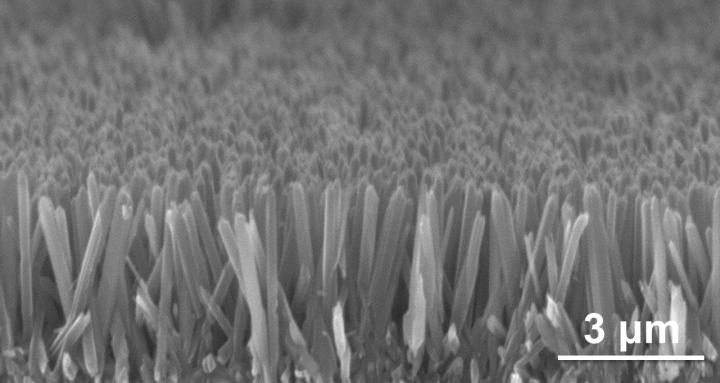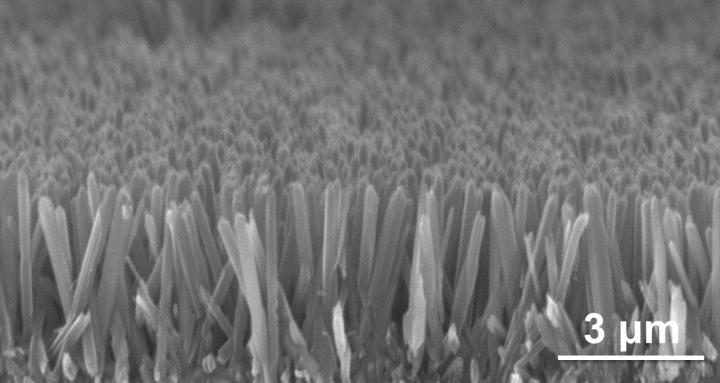
Credit: Qing Wang, Penn State
Firefighters entering burning buildings, athletes competing in the broiling sun and workers in foundries may eventually be able to carry their own, lightweight cooling units with them, thanks to a nanowire array that cools, according to Penn State materials researchers.
"Most electrocaloric ceramic materials contain lead," said Qing Wang, professor of materials science and engineering. "We try not to use lead. Conventional cooling systems use coolants that can be environmentally problematic as well. Our nanowire array can cool without these problems."
Electrocaloric materials are nanostructured materials that show a reversible temperature change under an applied electric field. Previously available electrocaloric materials were single crystals, bulk ceramics or ceramic thin films that could cool, but are limited because they are rigid, fragile and have poor processability. Ferroelectric polymers also can cool, but the electric field needed to induce cooling is above the safety limit for humans.
Wang and his team looked at creating a nanowire material that was flexible, easily manufactured and environmentally friendly and could cool with an electric field safe for human use. Such a material might one day be incorporated into firefighting gear, athletic uniforms or other wearables. They report their results in a recent issue of Advanced Materials.
Their vertically aligned ferroelectric barium strontium titanate nanowire array can cool about 5.5 degrees Fahrenheit using 36 volts, an electric field level safe for humans. A 500 gram battery pack about the size of an IPad could power the material for about two hours.
The researchers grow the material in two stages. First, titanium dioxide nanowires are grown on fluorine doped tin oxide coated glass. The researchers use a template so all the nanowires grow perpendicular to the glass' surface and to the same height. Then the researchers infuse barium and strontium ions into the titanium dioxide nanowires.
The researchers apply a nanosheet of silver to the array to serve as an electrode.
They can move this nanowire forest from the glass substrate to any substrate they want — including clothing fabric — using a sticky tape.
"This low voltage is good enough for modest exercise and the material is flexible," said Wang. "Now we need to design a system that can cool a person and remove the heat generated in cooling from the immediate area."
This solid state personal cooling system may one day become the norm because it does not require regeneration of coolants with ozone depletion and global warming potentials and could be lightweight and flexible.
###
Also working on this project were Guangzu Zhang, Houbing Huang and Qi Li, postdoctoral fellows in materials science and engineering; Xiaoshan Zhang and Jianjun Wang, graduate students in materials science and engineering and Long-Qing Chen, distinguished professor of materials science and engineering, all at Penn State.
The National Science Foundation supported this work.
Media Contact
A'ndrea Elyse Messer
[email protected]
814-865-9481
@penn_state
http://live.psu.edu





